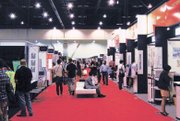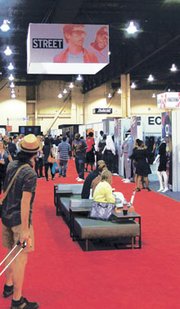Product and Location Drive Sales in Las Vegas
The slowly recovering economy made for a mixed message from the recent Las Vegas trade shows, where some exhibitors reported booming business, others reported solid but not stellar sales and a few failed to land any significant orders at all.
In August, Las Vegas played host to no fewer than 14 trade shows, including the massive MAGIC Marketplace, which encompasses several shows covering many segments of the industry, including its women’s show, WWDMAGIC, and men’s shows, Menswear, S.L.A.T.E., Street and Premium. In addition, there were the equally sprawling Project and much more compact Pooltradeshow, both owned by MAGIC parent Advanstar Communications, and Workroom, which is a jointly produced effort by Project and Pool. Advanstar also produces the Sourcing at MAGIC show and the new footwear show FN Platform. Other shows held concurrently included Offprice, MRket, Accessories The Show, ISAM, Moda Las Vegas, Capsule, CurveNV, Women’s Wear in Nevada and ENK Vegas.
Retailers were predominately upbeat, thanks to increases in sales over last year. Still, caution was the byword for many who came to the Las Vegas shows in search of solid, salable merchandise.
“We’re more optimistic about what Fall/Holiday will bring, but we are cautiously optimistic,” said Don Zuidema, co-founder of West Hollywood, Calif.–based menswear store LASC. “Economic news seems to be up then down—whether it is housing, employment or the stock market. It is affecting consumers’ psyches.”
Like many retailers shopping the show, Zuidema had slightly more open-to-buy than last year, but still he took a realistic approach to business in the coming year.
“We are realizing it is a new economy,” he said. “It is a new world. We need to embrace and accept that that is where we are today. We can say that we need to be sharper, work harder rather than avoiding the elephant in the room [a bad economy]. We deal with it. Some of it is painful and difficult. But it will provide us with new opportunities and re-energize us to make our businesses grow.”
For some, new opportunities meant delivering fashion faster.
“More people than ever were looking to order for next week than for next season,” said Christopher Wicks, founder of Los Angeles fashion company Defiance USA. At MAGIC’s Premium section, the company showed lines English Laundry, John Lennon Collection by English Laundry, Scott Weiland by English Laundry and Da Vinci. Wicks estimated his business increased 20 percent compared with the same show in the previous year.
For others, it was important to show up—and to show up with the right product. Laurel Berman, designer and founder of the Los Angeles–based Black Halo contemporary brand, reported a strong show at Project. “In general, it was a little slow, but all the shows aren’t what they used to be. If you have a good line, then people are still buying,” she said. “Right now it is important not to miss an opportunity to meet with buyers and make a sale. Every dollar counts.”
Buyers came to Project wanting to buy more of what is currently selling, Berman said. Immediates accounted for one-third of all her sales at Project.Growing shows
Many of the Las Vegas trade shows reported an uptick in exhibitors. This season’s MAGIC Marketplace featured 500 more exhibitors, showing in 150,000 more square feet of exhibition space than last year, according to show organizers, who said, overall, the MAGIC Marketplace featured 3,500 exhibitors showing 6,000 brands. In addition, MAGIC executives said attendance figures were up by about 8 percent over last year, and this season, buyers from more than 80 countries turned out, including department stores, big-box retailers, specialty stores and international buyers.
Advanstar’s small Workroom show returned for its second season (with twice the number of brands exhibiting from last year), in a space next door to Project. The show’s 45 exhibitors included a focused slice of fashion-forward brands in the men’s and women’s contemporary market, including Factory by Erik Hart, Left Field, LnA, Surface to Air and The Stronghold.
And the Offprice show, which reported strong attendance throughout the economic downturn of 2009, turned last year’s success into an opportunity to grow. The show moved from the ground floor of the Sands Expo and Convention Center to the second floor (which previously housed Project), where 1,152 booths were set up in the 115,000-square-foot ballrooms. The show drew 10,120 attendees, according to Offprice spokesperson Don Browne.
The Capsule trade show returned to The Venetian this season with a brand roster of more than 150 menswear, womenswear, footwear and accessories brands, including California brands Trovata, Copy, Orthodox, B:Scott, Crate, Comune, SLVDR, Skingraft, Seneca Rising and Riviera Club.
Minya Quirk, a co-founder of Capsule’s producer, New York–based BPMW, said the show attracted roughly 2,500 buyers, including a healthy dose of Japanese buyers. Seen on the show floor were buyers from independent specialty retailers and majors, including Bloomingdale’s, Saks Fifth Avenue, Anthropologie, Ron Herman, Holt Renfrew, Need Supply and Urban Outfitters.Splicing the market
Many of the trade shows found success by catering to a specific niche. That’s been the key to success for the Women’s Wear in Nevada show, which typically draws a loyal following of specialty retailers looking for updated, resort and plus-size merchandise.
“We got some really nice-size orders,” said Melody Fast, owner of the Melody Fast Showroom at the California Market Center in Los Angeles. “The stores that come here come to write. We definitely beat last year.”
For Moda Las Vegas exhibitor Maggie Bermudez, the show offered a more intimate setting than the massive MAGIC.
“My existing customers would not meet me at MAGIC because it’s so big,” said Bermudez, national sales manager for Silk Culture Fashion Manufacturing Ltd., which returned to the show after a season at the MAGIC Marketplace. “[At Moda this season], I got new customers I did not expect.”
Moda Las Vegas shared space with Accessories The Show and upscale men’s show MRket, all owned by Business Journals Inc.
MRket exhibitor Mark Maley described the show as “very strong.”
“Normally, you have one busy day, and the next it wanes,” said Maley, vice president of sales for Carnoustie, a fine men’s sportswear line based in Irvine, Calif. “But the first two days were strong, and the third kind of tapered off,” Maley said. “There was a lot of foot traffic, and most of the booths I saw were quite busy. The people who were there were there to work and not just looking.”
Exhibitors at ENK Vegas were similarly enthusiastic about the quality—if not the quantity—of the buyers shopping the show.
“There wasn’t the traffic that there was at Project. It was a higher quality of traffic,” said Natasha Marin, the director of the West Coast showroom for Genetic Denim and Decades Denim, the denim lifestyle collection, which launches for Spring 2011. Marin landed orders from buyers from Ron Herman, American Rag, Curve, E Street Denim, Planet Blue, Scoop and Revolveclothing.com for Immediates and Spring deliveries.
Jeff Shafer, owner of Agave denim, said the atmosphere of ENK encouraged buyers to get down to business. “Project—it reminds me of speed dating. People are running around and checking each other out,” Shafer said. “If you were an advanced contemporary denim retailer, you could shop 80 percent of the lines [at ENK]. That environment—the music and carpet and lighting—you can sit and work.”
Randy Brewer, owner of Convert in Berkeley, Calif., shopped Workroom, ENK Vegas and Project to find companies that manufactured domestically and used eco-friendly materials. At Workroom, Brewer said, the selection encompassed “a lot of really interesting and forward brands,” and he wrote Left Field, Kanvis and Dickie’s 1922 replica workwear for the first time at the show. “I like when they separate out a separate niche,” Brewer said.
Workroom exhibitor Hillary Taymour of Collina Strada moved her brand from Project to Workroom in the hopes of being more visible as one of the few accessories designers at the much smaller show. “Even though there was less traffic [than Project], I feel like people were coming to buy at Workroom. They weren’t just browsing,” Taymour said. “The buyers that walk into Workroom, they were looking for that aesthetic. They were more prone to write orders.”
Workroom drew buyers from Barneys Japan, Beams, Tobi, Urban Outfitters, Harvey Nichols, American Rag, Ships, Neiman Marcus, Oak and Holt Renfrew.
At Pool, exhibitors reported a marked downturn in traffic—which could have been due to the show’s new, harder-to-find location at the Mandalay Bay Convention Center. But still, buyers from U.S. chain stores and e-tail sites—such as Urban Outfitters, Hot Topic, 80s Purple, Oak and Metropark—as well as international buyers shopped the show.
Mitra Khayyam, the designer/founder of the Los Angeles–based Blood Is the New Black T-shirt label, said traffic in the aisles was down noticeably—especially among major retailers. “We had consistent Asian business; there were a lot of Japanese buyers at the show. But we didn’t see a lot of American buyers, especially the majors. Majors were missing,” she said. “But we still wrote [notes and orders]. A slower show just means I have to do more legwork, work a little harder. I’m not disappointed in [Pool].”New categories
Several shows opened new categories or shifted the mix within their shows.
At lingerie show CurveNV, the big news was the addition of swimwear to the mix. To kick off the new category, show organizers CURVexpo Inc., based in Riverside, Conn., hosted a burlesque-themed swimwear fashion show at Crazy Horse Paris at the MGM Grand.
“We wanted to produce something that would blow people away, and we think we achieved that, said Laurence Teinturier, CURVexpo’s executive vice president. Teinturier described the addition of swim to Curve’s mix as “a good surprise,” but she pointed out other burgeoning categories at the show, including men’s furnishings.
“We have a lot of requests for accessories, bath and body, yoga and fitness, also green or organic—we have a lot of demand for that,” she said.
The show featured a handful of fitness resources, as well as a few eco collections, but Teinturier said those categories could grow in the future.
Capsule’s Quirk said womenswear continues to be a growing focus for the show, which originally launched as a men’s-only show. Now, menswear accounts for 60 percent of Capsule’s offerings while womenswear has grown to 40 percent. Buyers, Quirk said, have responded well to the women’s contemporary and young designer brands at the show.
“We want to be as comprehensive a show as possible—from soup to nuts,” she said. Growing Capsule’s womenswear numbers falls into that category, but so do other less likely categories, including store fixtures and vintage garments. Irons & Duck sold store fixtures and furnishings on the show floor to retailers looking to redecorate their sales floors. And for the first time, Capsule included a cash-and-carry vintage section, which featured everything from archive-quality denim from the 1800s to vintage T-shirts from the ’60s and ’70s. “These categories add to the whole experience of the show,” Quirk said. Complete coverage of the Las Vegas trade shows can be found here.
























